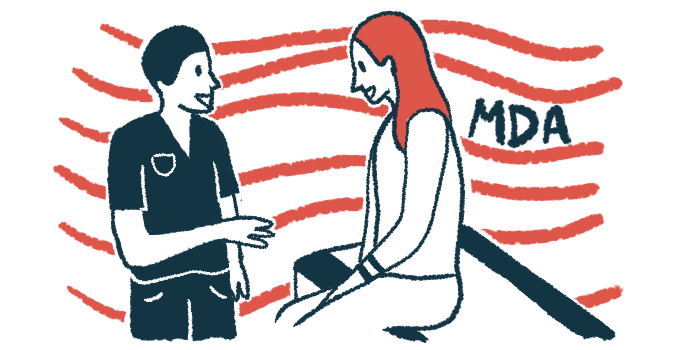MDA 2025: Duvyzat delays walking loss, lessens lung function decline
Therapy is approved in US to treat DMD patients ages 6 and older

Long-term treatment with Duvyzat (givinostat) may help delay the loss of walking ability and lessen the decline in lung function for boys with Duchenne muscular dystrophy (DMD), new analyses indicate.
The studies were presented in a series of posters at this year’s meeting of the Muscular Dystrophy Association (MDA).
Duvyzat is an oral therapy developed by ITF Therapeutics and approved in the U.S. to treat DMD patients ages 6 and older. It blocks the activity of histone deacetylases, a group of enzymes that help regulate the genetic activity of cells. According to Scott Baver, PhD, head of U.S. medical affairs at ITF, the exact mechanism of how Duvyzat exerts its beneficial effects in DMD isn’t fully clear, but available data indicate it can help lower inflammation, scarring, and fat infiltration into muscles.
“In preclinical models of Duchenne and in some of our earlier clinical trials, and even in our Phase 3 study, what we have seen is that Duvyzat is able to reduce inflammation, … reduce scarring and reduce fatty infiltration into muscle, thereby improving outcomes,” Baver said in an interview with Muscular Dystrophy News Today during the MDA meeting.
Better motor function scores with Duvyzat
Duvyzat’s approval was based mainly on data from the Phase 3 EPIDYS clinical trial (NCT02851797), which tested it against a placebo in 179 boys with DMD, ages 6-17, who were able to walk. All the patients were given corticosteroids, long a mainstay of DMD care.

Scott Baver, PhD, is head of U.S. medical affairs at ITF Therapeutics. (Photo by Kellie Benn)
Analyses in EVIDYS focused primarily on patients with fat levels between 5% and 30% in a muscle of the thigh. These patients were the analysis target because they were judged most likely to show measurable declines over the study. But the trial also included those with more or less fat in the thigh muscle. “The rationale for that was to look at safety in a broader patient population,” Baver said.
An analysis at MDA showed that, in patients with higher or lower levels of fat in their thigh muscle, those given Duvyzat tended to have better scores on motor function measurements than those on a placebo.
“Each individual is different,” Baver said. “If we can say you’re here in your disease progression, versus you’re there in this disease progression, and it will still have that same potential effect on your muscle — that to me is probably the most encouraging aspect.”
After the 18-month-long placebo-controlled part of the study ended, most patients entered an extension study (NCT03373968) where all are being treated with Duvyzat and monitored for long-term outcomes.
Long-term data from the extension study have so far not revealed any unexpected safety issues, but common side effects of Duvyzat include diarrhea, abdominal pain, increased blood fat levels, and low platelet counts. Baver said these issues can usually be managed with appropriate monitoring and patients can reduce their dosage if they have problematic side effects.
“We’ve developed a treatment protocol with the doses that we have where if you have a decrease in platelets or an increase in [digestive issues], you can actually reduce your dose — we call it flexible dosing — to help manage those particular symptoms,” Baver said.
In several presentations at MDA, findings from the long-term extension were compared against data from natural history trials that assessed the trajectory of the disease in the absence of treatment, apart from corticosteroids. Although comparisons between trials and natural history data are not the gold standard for clinical research, Baver said these comparisons can help assess long-term outcomes, since it wouldn’t be ethical to give a placebo to patients for years and years after the trial is done.
“I think what’s fantastic about this community in Duchenne is that there’s so much data from the community that allows us to be able to explore our dataset,” Baver said. “There’s really nice, rich datasets … it gives us in the pharmaceutical and biotechnology industries the ability to say we want all of our patients to be on therapy and be able to compare our data to what we should expect as part of the natural history.”
Walking ability, climbing stairs
In one poster, researchers compared the time at which patients on Duvyzat lost the ability to walk. The median age at loss of walking ability in patients on Duvyzat was 18.1, but 15.2 for patients in the natural history study. Baver said these analyses aren’t fully mature because many patients on Duvyzat remain able to walk and complete other motor functions.
“As that data matures more … as the time progresses, we’ll be able to be more confident on what those actual numbers are. So it could be in the long term that we’re able to provide more benefit,” he said, adding ITF is “committed to getting this information to the community” as soon as it’s available.
Similar differences were seen for the median time to lose the ability to go up a short set of stairs (17.9 vs. 13.9) and rise from the floor (14.9 vs. 12.9). These data reflect “not just function, but also strength,” Baver said. “Having the ability to to climb up stairs, it requires you to be able to move your legs, but also the strength to do it.”
“For me, that goes back to what’s important for the patient, being able to maintain the ability to walk … to get upstairs, [and] to do their daily tasks,” he said.
DMD’s effect on breathing
DMD also impacts the muscles in the chest that are needed to breathe. In studies, breathing is usually assessed with a measurement called forced vital capacity (FVC), which tracks how much air someone can blow out in a forceful breath.
A separate comparison against natural history data showed that, before loss of walking ability, FVC declined at similar rates in DMD boys on Duvyzat and those in the natural history data. But after boys lost the ability to walk, FVC worsened much faster in the natural history data. By two years after the loss of ambulation, the average FVC score was 74.4% for patients in the trial given Duvyzat and 62.5% in the natural history study.
This finding “is encouraging because this disease doesn’t just include the ability to walk or the ability to feed yourself. It also is really critical to find potential therapeutic options for being able to breathe,” Baver said.
ITF is working on more studies to further explore the effects of Duvyzat in DMD. At the MDA meeting, the company presented the design for an observational study to track outcomes from its use among boys in the U.S. The study is expected to include patients taking other DMD treatments including gene therapy and exon-skipping therapies.
“We know here in the U.S. that there are other therapies available. We listen to not just physicians, but patients to say, what data do you need to see as you’re going through your treatment decisions?” said Baver, who said the lack of information on combining treatments is an “obvious data gap.”
“One way of [filling this gap] is having a very rigorous observational study that we’ve created to give us the ability to get information to the community so they can help make their better treatment decisions,” he said.
A Phase 3 study called ULYSSES (NCT05933057) is testing Duvyzat in people with DMD who cannot walk and another trial (NCT06769633) is testing the therapy’s safety and pharmacological properties in children with DMD, ages 2-5. ULYSSES is recruiting patients at 20 centers in Canada and Europe, while the study in young children is recruiting at nine sites in Europe.








